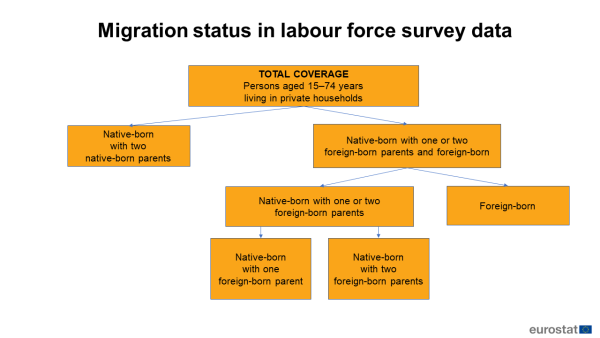Foreign-born people and their descendants - main characteristics
Data extracted August 2023.
Planned article update: July 2024.
Highlights
In the EU in 2022, around one-fifth (21%) of people living in private households aged 15-74 years were either a descendant of foreign-born persons or themselves foreign-born.
In the EU in 2022, 99% of native-born persons in private households with only one foreign-born parent were citizens of the Member State where they lived. This share was 85 % for native-born persons with two foreign-born parents and 40% for foreign-born persons.
In the EU in 2022, 17% of foreign-born persons living in private households were youths aged 15-29 years. This was higher among native-born persons with two native-born parents (20%) and for persons who were native-born with either one (31%) or two (41%) foreign-born parents.
This article is one of a set of statistical articles concerning foreign-born people and their immediate descendants in the EU. This article forms part of an online publication. It presents statistics on the migration status of persons aged 15-74 years usually residing in private households in the European Union (EU), in its individual Member States, as well as three EFTA countries (Iceland, Norway and Switzerland).
As illustrated in Figure 1, the migration status distinguishes between
- native-born persons with two native-born parents,
- native-born persons with one or two foreign-born parents and
- foreign-born persons.
Full article
Overview by migration status
Persons living in private households can be categorised in terms of their migration status. In 2022, the EU's population in private households aged 15-74 years was composed as follows:
- almost eight out of ten (79.0 %) were native-born with two native-born parents,
- around one-fifth (21.0 %) were native-born persons with at least one foreign-born parent or were themselves foreign-born,
- 7.2 % were native-born descendants of foreign-born parents, of which
- 4.2 % had one foreign-born parent,
- 3.0 % had two foreign-born parents,
- 13.7 % were foreign-born.
- 7.2 % were native-born descendants of foreign-born parents, of which
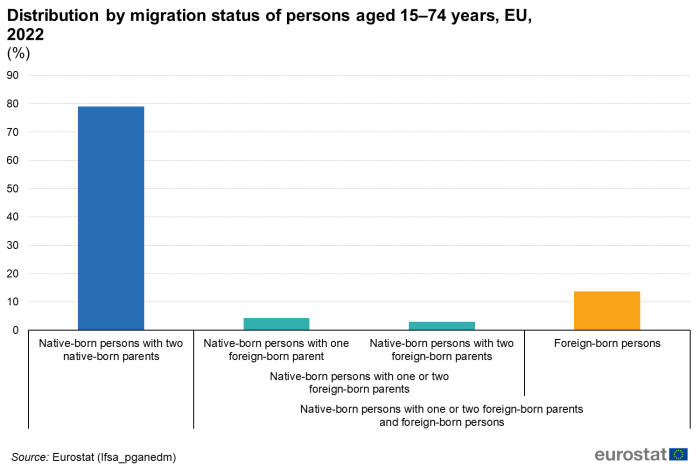
(%)
Source: Eurostat (lfsa_pganedm)
The same distribution is shown in Table 1 at the national level.

(%)
Source: Eurostat (lfsa_pganedm)
Among the EU Member States, the share of foreign-born persons among people aged 15-74 years ranged from less than 1.0 % to more than 50 % in 2022.
- The share was lowest in Romania (0.2 %), Bulgaria (0.4 %) and Poland (0.7 %). It was also below 5.0 % in Slovakia, Hungary and Czechia.
- 13 EU Member States recorded shares between 5.0 % and 20.0 %.
- Towards the other end of the ranking, this share was between one-fifth and one-quarter in Germany, Belgium, Austria, Sweden and Ireland and slightly higher in Cyprus (26.9 %) and Malta (27.8 %).
- By far the highest share was observed in Luxembourg, where nearly three-fifths (55.5 %) of persons aged 15-74 years were foreign-born.
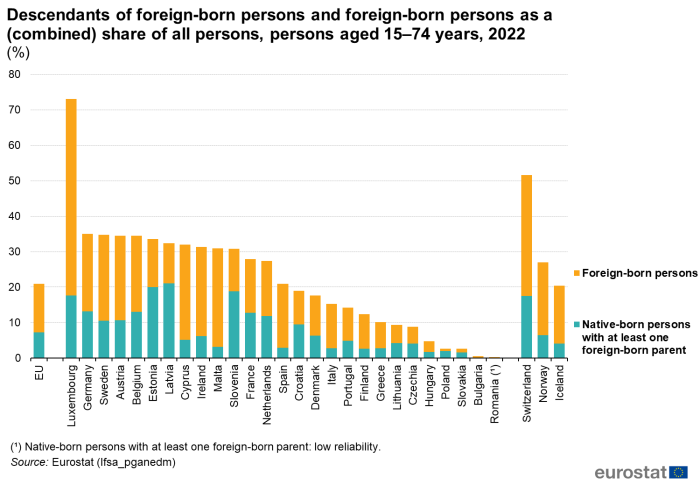
(%)
Source: Eurostat (lfsa_pganedm)
A combined share of foreign-born persons and all native-born persons with at least one foreign-born parent is shown in Figure 3 for 2022.
- With this expanded coverage, Romania, Bulgaria, Slovakia and Poland recorded the lowest shares among the EU Member States.
- Shares below one-tenth were observed in a further three EU Member States (Hungary, Czechia and Lithuania) and between 10.0 % and 15.0 % in another three (Greece, Finland, Portugal and Italy).
- Most other EU Member States recorded shares between one-fifth and one-third.
- Luxembourg recorded by far the highest share, close to three-quarters (73.0 %).
Country of birth of the foreign-born
This section focuses just on the foreign-born persons, looking at whether they were born in another EU Member State or in a non-EU country.
In 2022, almost three-tenths (28.6 %) of foreign-born persons aged 15-74 years living in the EU had been born in another EU Member State compared with a much larger share of 71.4 % who had been born in a non-EU country.
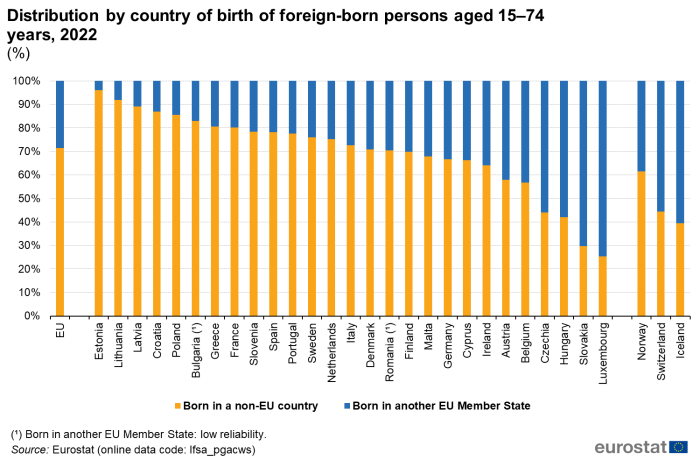
(%)
Source: Eurostat (lfsa_pgacws)
In 2022, there were 23 EU Member States where a majority of foreign-born persons aged 15-74 years had been born in a non-EU country – see Figure 4. The four exceptions, where a majority of foreign-born persons had been born in another EU Member State, were Luxembourg, Slovakia, Hungary and Czechia. The highest shares of foreign-born persons born in a non-EU country were in the three Baltic Member States: Latvia, Lithuania and Estonia.
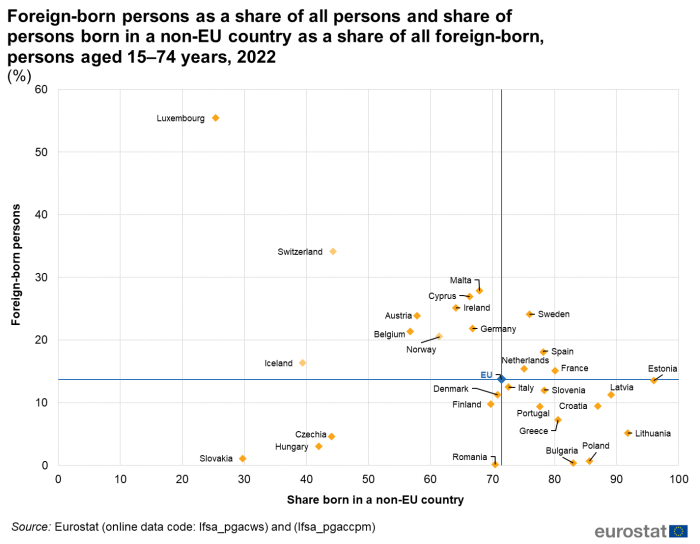
(%)
Source: Eurostat (lfsa_pgacws) and (lfsa_pgaccpm)
Figure 5 contrasts the share of foreign-born persons in the population, with the share of these people who were born in a non-EU country. The blue lines in the figure are centred on the EU averages: 13.7 % of the population in 2022 were foreign-born persons and 71.4 % of these foreign-born persons had been born in a non-EU country.
- Luxembourg had a high share of foreign-born persons (55.5 %), combined with a low share of people who were born in a non-EU country (25.4 %).
- Slovakia also had a low share of foreign-born persons who were born in a non-EU country (29.7 %) but combined with a low share of foreign-born persons in its population (1.1 %).
- As already noted, the Baltic Member States had the highest shares of foreign-born persons who were born in a non-EU country (89.1-96.0 %). In Lithuania, this was combined with a relatively low share of foreign-born persons (5.1 %), whereas the share of the foreign-born persons in Latvia and Estonia was higher (11.3 % and 13.4 %, respectively) however still below the EU average.
Citizenship of foreign-born and their descendants
A new-born child's citizenship is often determined by their place of birth or the citizenship of one or both of their parents. Citizenship can also be acquired later in life, for example, after a number of years' residency in a country. As such, it is common to find higher rates of citizenship for a particular country among native-born rather than foreign-born persons and among persons with at least one native-born parent rather than with two foreign-born parents.
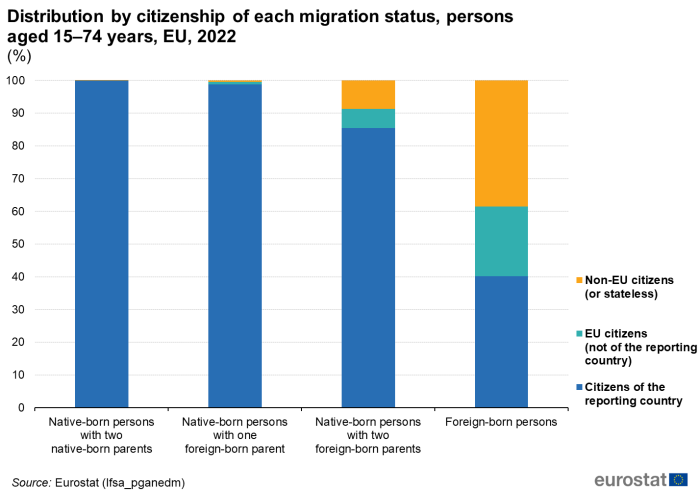
(%)
Source: Eurostat (lfsa_pganedm)
Among all native and foreign-born persons aged 15-74 years in the EU in 2022, 91.3 % were citizens of the EU Member State where they lived, 3.1 % had the citizenship of another Member State and 5.6 % were citizens of a non-EU country (or were stateless).
Figure 6 provides the same analysis for four categories of migration status of people in the EU in 2022. Among native-born persons with two native-born parents, practically all were citizens of the EU Member State where they lived. This share was only marginally lower (98.8 %) among native-born persons with one foreign-born parent.
The share of people with the citizenship of the EU Member State where they lived in 2022 was notably lower among native-born persons with two foreign-born parents, at 85.5 %. Among this category, 8.7 % had the citizenship of a non-EU country (or were stateless) and a slightly lower proportion (5.8 %) had the citizenship of another Member State.
For foreign-born persons living in the EU, the citizenship structure in 2022 was quite different. Around two-fifths (40.1 %) had the citizenship of the EU Member State where they lived (either because they were born abroad with that citizenship or had acquired it through a process such as naturalisation). A slightly smaller share (38.5 %) had the citizenship of a non-EU country (or were stateless). Just over one-fifth (21.4 %) were citizens of a Member State other than the one where they lived.
Figure 7 presented below focuses on the citizenship structure of foreign-born persons.
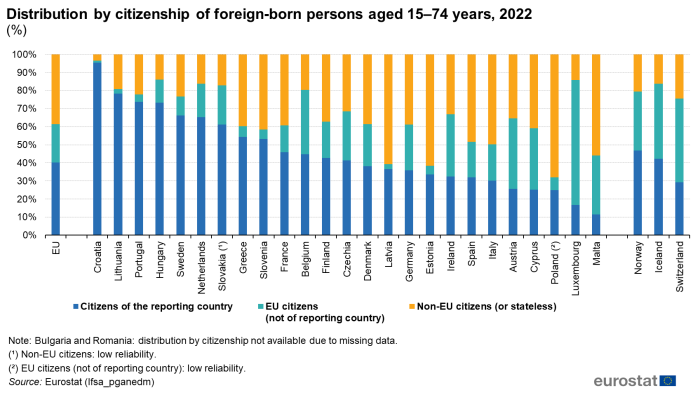
(%)
Source: Eurostat (lfsa_pganedm)
In 2022, Croatia recorded the highest share (95.5 %) of foreign-born persons with the citizenship of where they lived. (There were no data for Bulgaria and Romania.) This was notably higher than the next highest share (78.4 % in Lithuania). In 16 EU Member States, less than half of foreign-born persons had the citizenship of the Member State where they lived. This share was below one-quarter in Poland, Luxembourg and Malta, all of which (most notably Luxembourg) had high proportions of foreign-born persons with the citizenship of another EU Member State. The highest shares of foreign-born persons who had the citizenship of a non-EU country or who were stateless were in Poland, Estonia and Latvia (all over three-fifths).
Age structure of the native and foreign-born
The analyses here concern the age structure of the population. Two age classifications are presented.
- The first comprehensively divides the whole surveyed population into three separate age groups:
- 15-29 years (referred to as youth),
- 30-54 years,
- 55-74 years.
- The second shows one age group, persons aged 20-64 years, as a share of all persons aged 15-74 years. This age group is of particular interest as it is the focus for employment analyses in the Action Plan on Integration and Inclusion 2021–2027.

(%)
Source: Eurostat (lfsa_pganedm)
The age structure is quite different according to migration status. In particular, the share of young people varies considerably. In the EU in 2022, 17.5 % of all foreign-born persons were youths: this share was slightly higher among native-born persons with two native-born parents (20.3 %) and notably higher for both categories of persons who were native-born with either one (30.9 %) or two (40.8 %) foreign-born parents.
The opposite was observed for people aged 30-54 years: the largest share in this age group was observed for foreign-born persons (56.2 %) and the smallest shares for persons who were native-born with either two foreign-born parents (38.8 %) or one foreign-born parent (37.0 %).
For the age group 55-74 years old, the share was larger for native-born persons with two native-born parents (35.3 %) than for any of the other categories of migrant status: the lowest share was among native-born persons with two foreign-born parents (20.4 %).
The share of persons aged 20-64 years among the persons aged 15-74 years was quite similar among all native-born persons, regardless of whether they had two native-born parents, two foreign-born parents, or one native-born and one foreign-born parent. In the EU in 2022, the share for these three categories ranged from 73.7 % to 77.3 %. By contrast, 86.0 % of all foreign-born persons aged 15-74 years were in the age group 20-64 years.
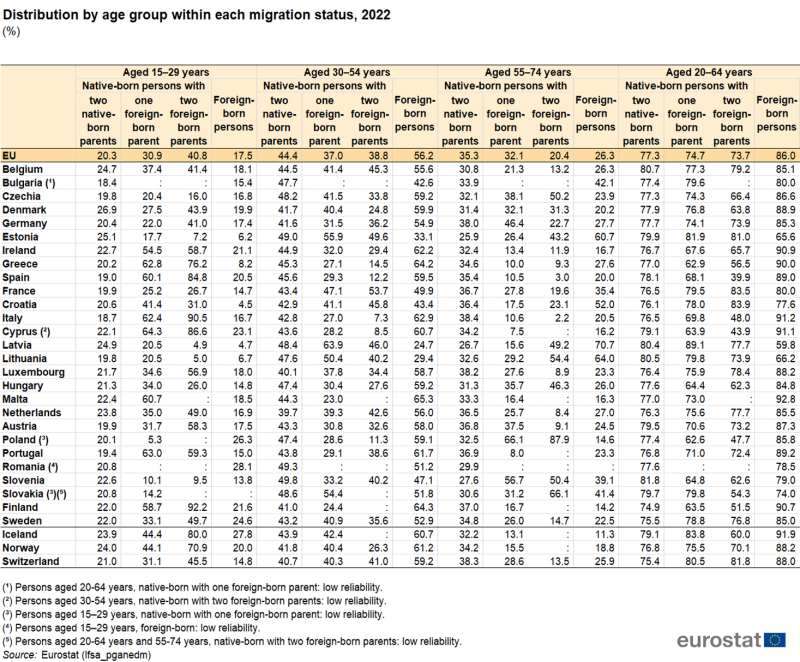
(%)
Source: Eurostat (lfsa_pganedm)
The same distribution is shown in Table 2 at the national level. A majority of EU Member States observed that the share of young people in the total population in 2022 was least among foreign-born persons. Equally, the largest share of people aged 30-54 years in 2022 was observed for foreign-born persons in a large majority of the EU Member States.
Looking at each migration status in turn indicates that the age structure for native-born persons with two native-born parents was relatively similar across all EU Member States. Among the three other categories (among the EU Member States with reliable data), the structures were much more varied in 2022. For example, for foreign-born persons the shares ranged from
- 4.5 % in Croatia to 26.3 % in Poland for those aged 15-29 years;
- 24.7 % in Latvia to 65.3 % in Malta for those aged 30-54 years;
- 14.2 % in Finland to 70.7 % in Latvia for those aged 55-74 years.
Sex structure of the native and foreign-born
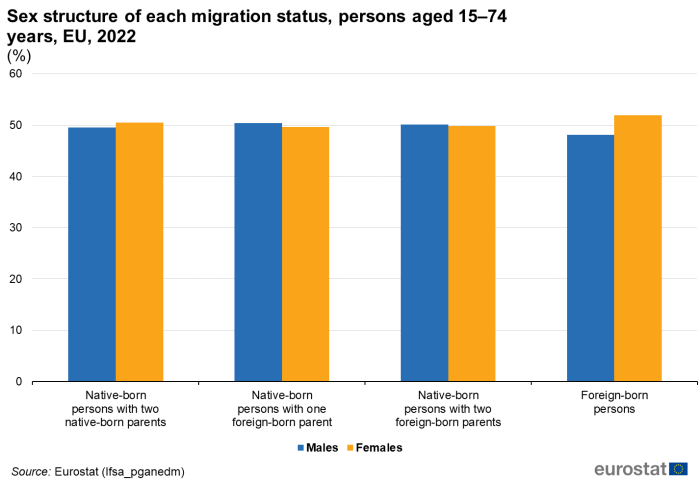
(%)
Source: Eurostat (lfsa_pganedm)
For the three native-born categories, there was a fairly even split in 2022 in the shares of males and females in the EU (see Figure 9): the difference – with more females than males – was 1.0 percentage points (pp) among those with two native-born parents. By contrast, there were more males than females among the subpopulation with one foreign-born parent (a difference of 0.8 pp) and the subpopulation with two foreign-born parents (a difference of 0.3 pp).
Among foreign-born persons in the EU in 2022, the difference was notably greater: the share of females was 3.9 points higher than the share of females.
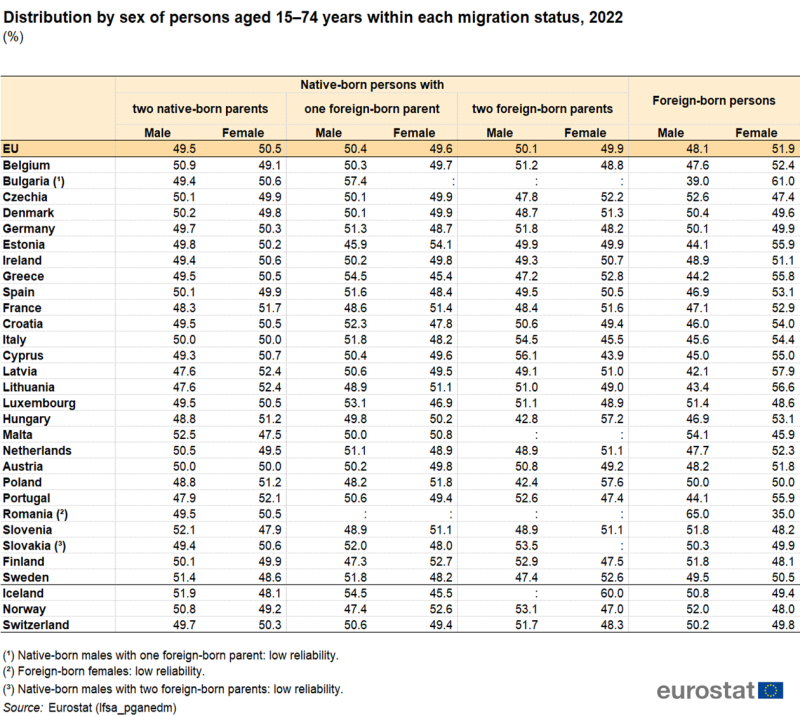
(%)
Source: Eurostat (lfsa_pganedm)
The analysis by sex highlights a few EU Member States where there were relatively large differences between the shares of males and females in certain categories of migration status. By far the largest difference of all was for foreign-born persons in Romania, where the share of males in 2022 was 65.0 % compared with 35.0 % for females. The next largest difference was in Bulgaria, with more females than males among the foreign-born persons. In Poland, the share of females was notably greater than the share of males among native-born persons with two foreign-born parents.
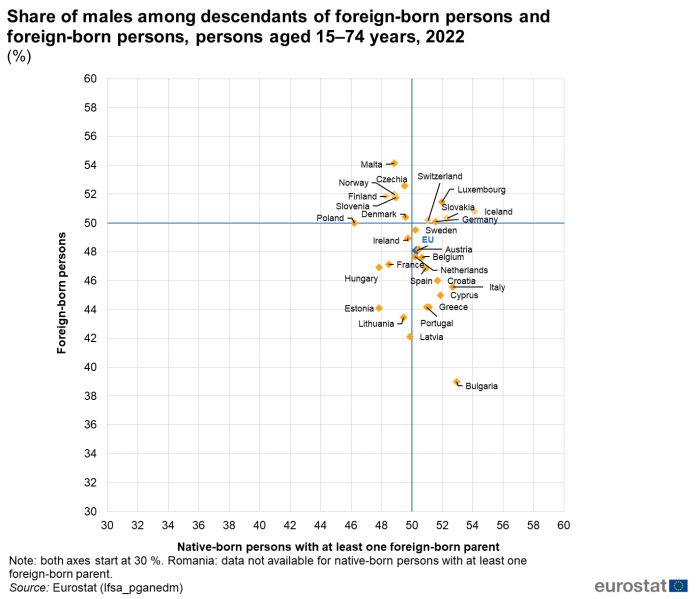
(%)
Source: Eurostat (lfsa_pganedm)
A contrast between the shares of males within the foreign-born category with the equivalent share among native-born persons with at least one foreign-born parent is presented in Figure 10. The blue lines in the figure show where there is an equal share of males and females.
As noted earlier, in the EU the share of males was clearly lower than the share of females among the foreign-born persons, a difference of 3.8 pp. Among native-born persons with at least one foreign-born parent, the shares for each sex were quite similar, the difference being just 0.6 pp.
The relatively large differences noted for Bulgaria and Poland can be seen by the position of these two EU Member States in the figure: Poland as the Member State furthest to the left and Bulgaria at the bottom. Romania is not shown in Figure 10 as data is not available for native-born persons with at least one foreign-born parent.
Urban–rural structure of the native and foreign-born
An analysis by degree of urbanisation is based on the population density where people live and in surrounding areas (that form geographical clusters).
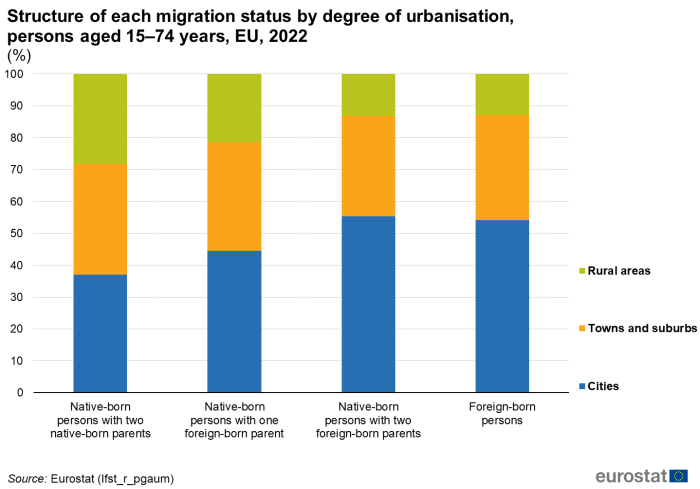
(%)
Source: Eurostat (lfst_r_pgaum)
In the EU, 37.1 % of native-born persons with two native-born parents lived in cities in 2022. This was the least share in cities among the four migration status categories. A somewhat larger share was observed for native-born persons with one foreign-born parent (44.6 %), while a majority of native-born persons with two foreign-born parents (55.4 %) and foreign-born persons (54.1 %) lived in cities.
Between the two ends of the degree of urbanisation scale, similar shares of people lived in towns and suburbs in the EU in 2022 regardless of their migration status. This share ranged from 31.4 % among native-born persons with two foreign-born parents to 34.6 % among native-born persons with two native-born parents.
For people living in rural areas in the EU, a similar pattern was observed to that for cities, but in reverse. The largest share of people in rural areas was recorded for native-born persons with two native-born parents, 28.3 % in 2022, followed by a slightly smaller share among native-born persons with one foreign-born parent (21.4 %). Notably lower shares for rural areas were observed for native-born persons with two foreign-born parents (13.2 %) and for foreign-born persons (12.8 %).
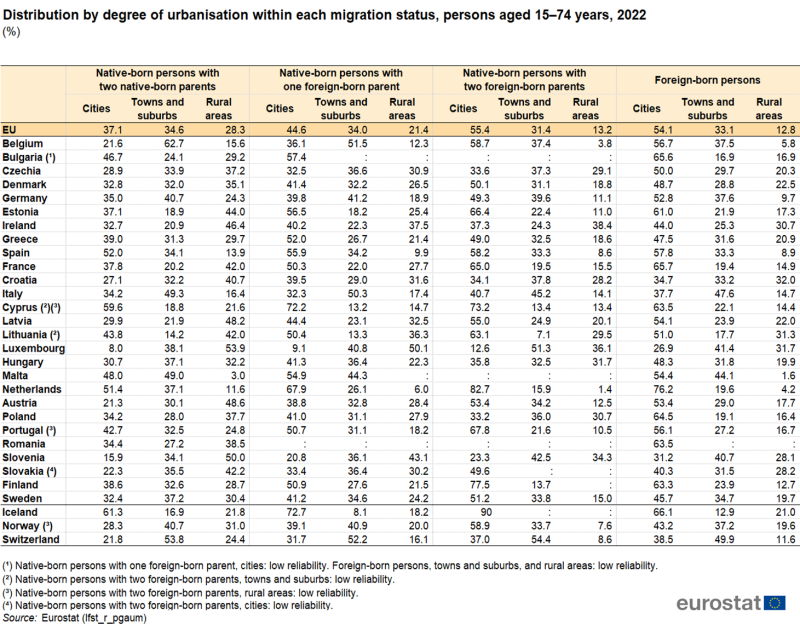
(%)
Source: Eurostat (lfst_r_pgaum)
A large majority of EU Member States observed that the share of people aged 15-74 years living in cities was least in 2022 among native-born persons with two native-born parents. The only exceptions, among the Member States for which complete and reliable data for cities are available (see Table 4), were Italy and Poland. The lowest shares of people living in cities, among all four categories of migration status, were observed in Luxembourg. On the contrary, Cyprus recorded the highest share of people living in cities among native-born persons with two native-born parents and native-born persons with one foreign-born parent. Among native-born persons with two foreign-born parents and foreign-born persons, the highest shares were observed in the Netherlands.
As was the case for the EU as a whole, most EU Member States recorded quite similar shares for the proportion of people living in towns or suburbs, regardless of their migration status. There were three notable exceptions: in Belgium, the share of native-born persons with two native-born parents living in towns and suburbs was notably higher than for the three other categories of migration status. In Poland, the share of foreign-born persons living in towns and suburbs was particularly low while that for native-born persons with two foreign-born parents was relatively high. In the Netherlands, the share of native-born persons with two foreign-born parents living in towns and suburbs was particularly low while that for native-born persons with two native-born parents was relatively high.
In vast majority of EU Member States with complete and reliable data, the least share of people aged 15-74 years living in rural areas in 2022 was observed either for native-born persons with two foreign-born parents or for foreign-born persons. Equally, in all Member States except for Italy, the share of people aged 15-74 years living in rural areas was largest in 2022 among native-born persons with two native-born parents. In Italy, a higher share was observed for native-born persons with one foreign-born parent.

(%)
Source: Eurostat (lfst_r_pgaum)
Figure 12 compares the share of people living in rural areas for foreign-born persons and descendants of foreign-born persons with the same share for native-born persons with two native-born parents. The blue line indicates where equal shares would be observed for these two groups. This illustrates that in all EU Member States native-born persons with two native-born parents were more likely to live in rural areas than were people with a different migration status. The largest differences in percentage point terms were observed in Austria, Estonia, France, Latvia and Luxembourg. The narrowest differences were observed in Italy and Malta, both of which had relatively small rural populations.
Source data for tables and graphs
Data sources
The data presented in this article are from the labour force survey (LFS), the largest household sample survey in the EU. The survey covers the resident population, defined as all people usually residing in private households. As such, persons living in collective households are excluded from the target population. Usual residence means the place where a person normally spends the daily period of rest, regardless of temporary absences for purposes of recreation, holidays, visits to friends and relatives, business, medical treatment or religious pilgrimage. The data for the EU are aggregated results for the 27 EU Member States. For more information on the data sources used, please consult the online publication EU labour force survey.
Due to the sampling nature of the survey, some data have low reliability or are not published due to very low reliability or confidentiality. Data that are of low reliability are duly marked in the footnotes below the figures and tables.
Calculation of shares in totals
Nearly all of the tables and figures in this article present shares of a total. For some of the studied breakdowns, e.g. by migration status, country of birth or citizenship, there is a certain amount of non-response (also called 'not stated' or 'unknown'). Wherever possible, the calculation of shares in this article is based on a total excluding the number of people classified in the not stated or unknown categories. As such, all exhaustive breakdowns presented in tables should sum to 100.0 % (allowing for rounding errors).
Context
The data in this article provide information not only on foreign-born persons living in the EU but also about native-born persons with at least one foreign-born parent.
Successful integration may lead to economic and social benefits for migrants and for the society where they live. More information on the policies and legislation in force in this area can be found in an introductory article: Migrant integration statistics introduced.
Direct access to
Online publications
Methodology
- LFS series – Detailed annual survey results (ESMS metadata file – lfsa_esms)
- EU labour force survey
